TOYOTA tC 2013 (in English) Manual PDF
Manufacturer: TOYOTA, Model Year: 2013, Model line: tC, Model: TOYOTA tC 2013Pages: 484, PDF Size: 9.1 MB
Page 71 of 484
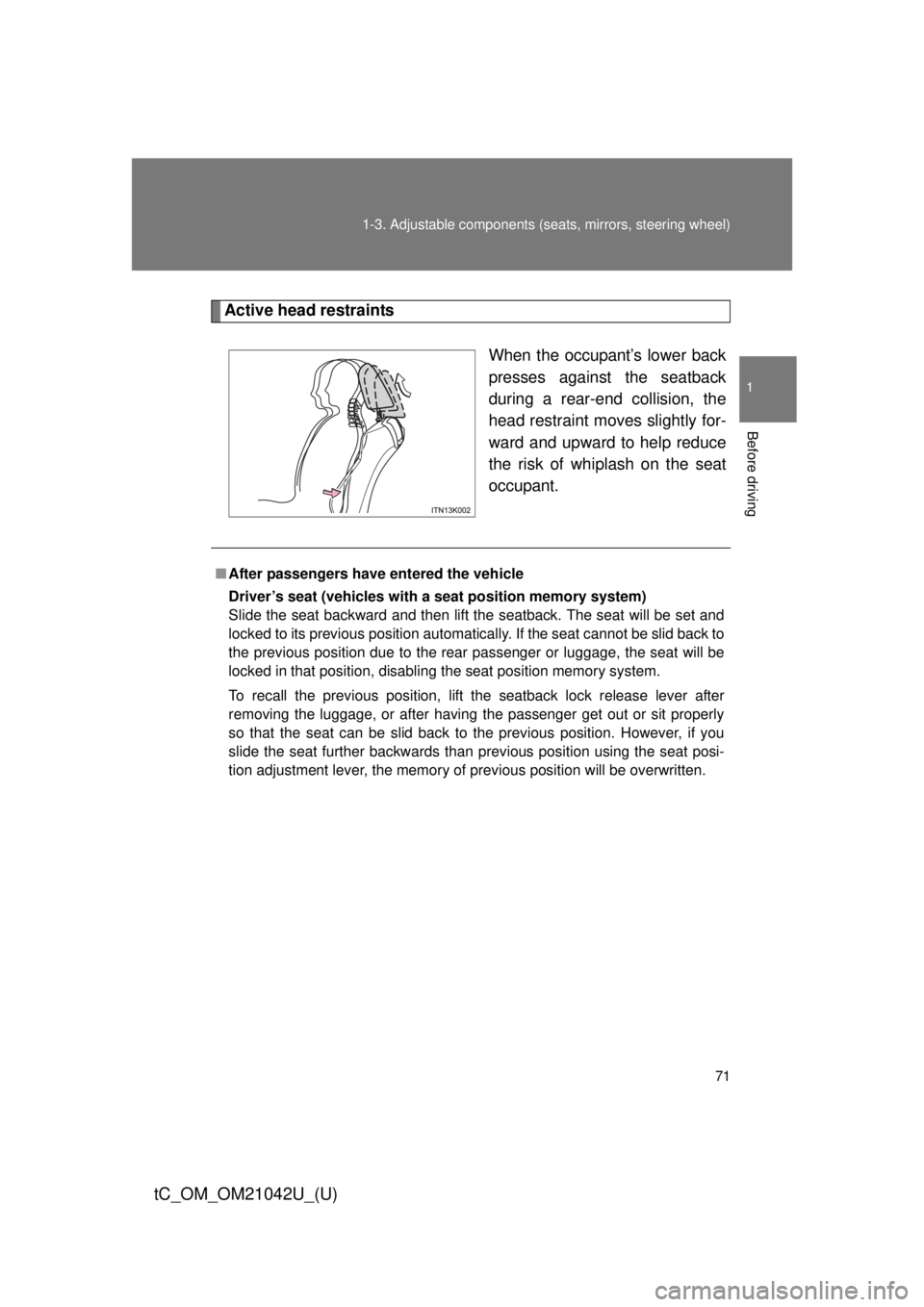
71
1-3. Adjustable components (s
eats, mirrors, steering wheel)
1
Before driving
tC_OM_OM21042U_(U)
Active head restraints
When the occupant’s lower back
presses against the seatback
during a rear-end collision, the
head restraint moves slightly for-
ward and upward to help reduce
the risk of whiplash on the seat
occupant.
■After passengers have entered the vehicle
Driver’s seat (vehicles with a seat position memory system)
Slide the seat backward and then lift the seatback. The seat will be set and
locked to its previous position automatically. If the seat cannot be slid back to
the previous position due to the rear pa ssenger or luggage, the seat will be
locked in that position, disabling the seat position memory system.
To recall the previous position, lift the seatback lock release lever after
removing the luggage, or after having the passenger get out or sit properly
so that the seat can be slid back to the previous position. However, if you
slide the seat further backwards than previous position using the seat posi-
tion adjustment lever, the memory of previous position will be overwritten.
Page 72 of 484
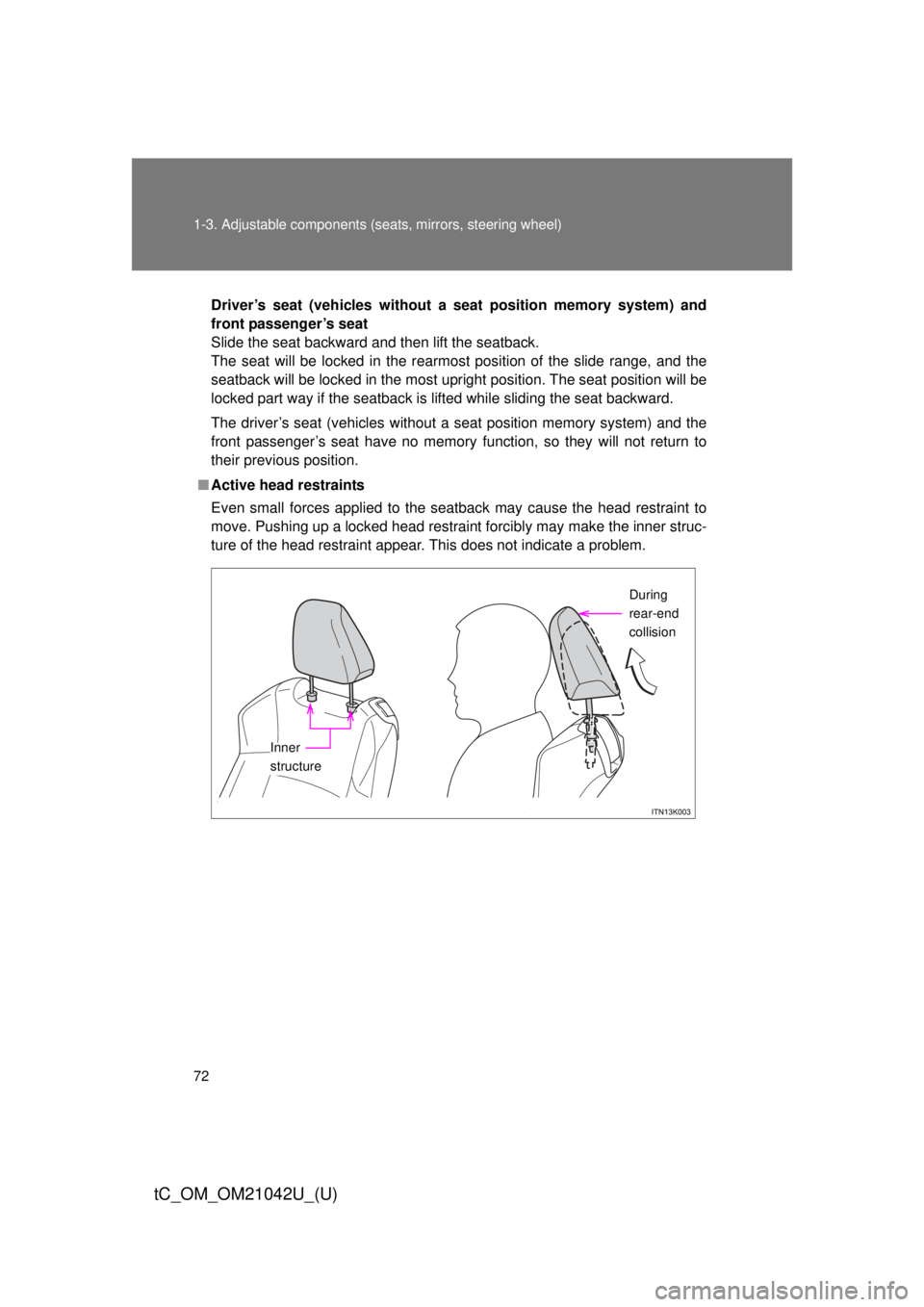
72 1-3. Adjustable components (seats, mirrors, steering wheel)
tC_OM_OM21042U_(U)
Driver’s seat (vehicles without a seat position memory system) and
front passenger’s seat
Slide the seat backward and then lift the seatback.
The seat will be locked in the rearmost position of the slide range, and the
seatback will be locked in the most upright position. The seat position will be
locked part way if the seatback is lifted while sliding the seat backward.
The driver’s seat (vehicles without a seat position memory system) and the
front passenger’s seat have no memory function, so they will not return to
their previous position.
■ Active head restraints
Even small forces applied to the seatback may cause the head restraint to
move. Pushing up a locked head restraint forcibly may make the inner struc-
ture of the head restraint appear. This does not indicate a problem.
During
rear-end
collision
Inner
structure
Page 73 of 484

73
1-3. Adjustable components (s
eats, mirrors, steering wheel)
1
Before driving
tC_OM_OM21042U_(U)
CAUTION
■Seat adjustment
● To reduce the risk of sliding under the lap belt during a collision, do not
recline the seat more than necessary.
If the seat is too reclined, the lap belt may slide past the hips and apply
restraint forces directly to the abdomen, or your neck may contact the
shoulder belt, increasing the risk of death or serious injury in the event of
an accident.
Adjustments should not be made while driving as the seat may unexpect-
edly move and cause the driver to lose control of the vehicle.
● After adjusting the seat, make sure that the seat is locked in position.
● Never allow anyone to touch seatback lock release levers while the vehi-
cle is moving.
● If anyone is in the vicinity, make sure they are clear of the seat back path
and let them know that the seat is about to move.
■ After returning the seatback to the upright position
Make sure the seatback is securely locked by pushing it forward and rear-
ward. Failure to do so may result in death or serious injury.
NOTICE
■To prevent the seat lock mechanism malfunction
Do not use the seatback angle adjustment lever and seatback lock release
lever at the same time. If they are used together, the seat lock mechanism
may be damaged.
Page 74 of 484
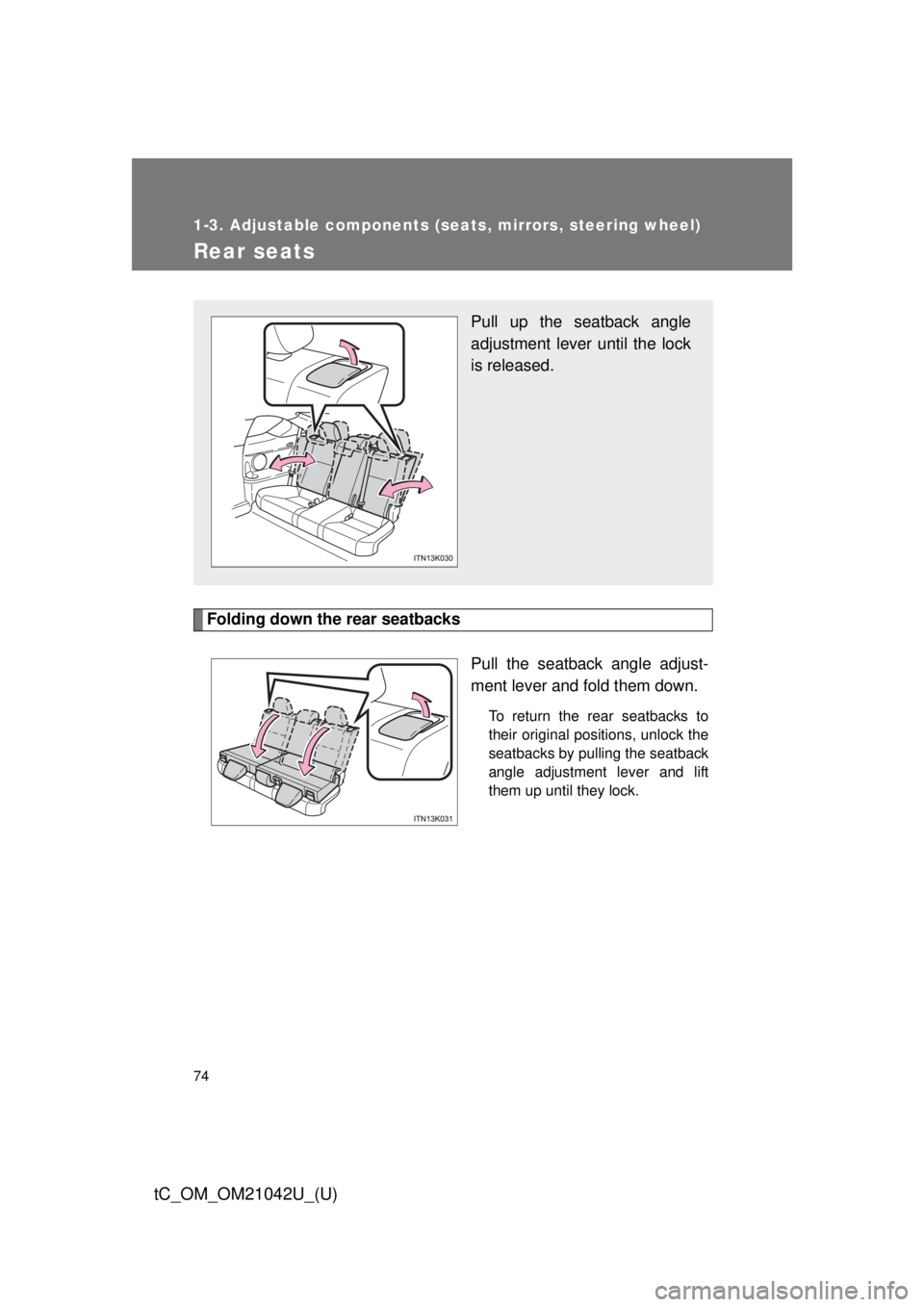
74
1-3. Adjustable components (seats, mirrors, steering wheel)
tC_OM_OM21042U_(U)
Rear seats
Folding down the rear seatbacksPull the seatback angle adjust-
ment lever and fold them down.
To return the rear seatbacks to
their original positions, unlock the
seatbacks by pulling the seatback
angle adjustment lever and lift
them up until they lock.
Pull up the seatback angle
adjustment lever until the lock
is released.
Page 75 of 484
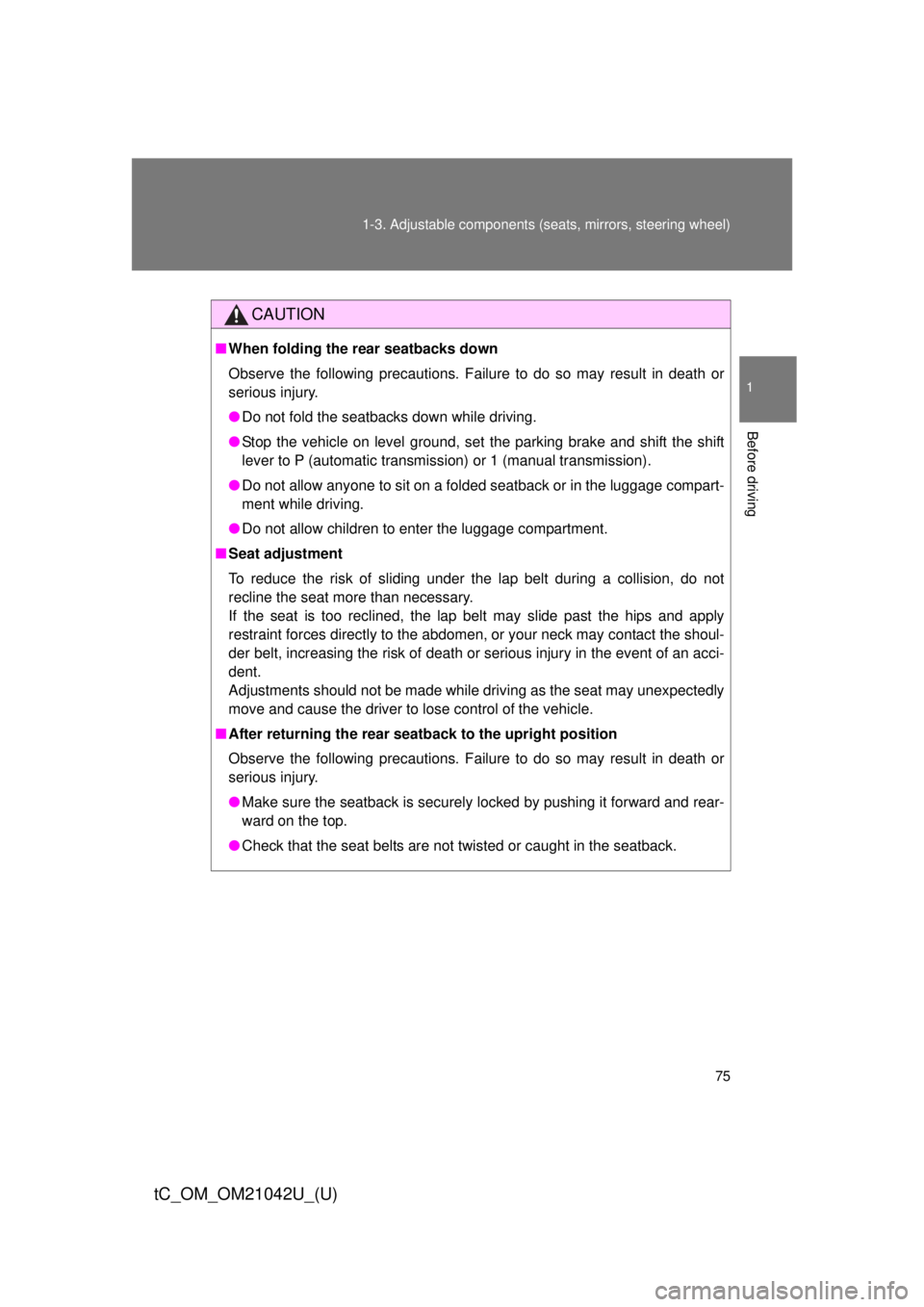
75
1-3. Adjustable components (s
eats, mirrors, steering wheel)
1
Before driving
tC_OM_OM21042U_(U)
CAUTION
■When folding the rear seatbacks down
Observe the following precautions. Failure to do so may result in death or
serious injury.
● Do not fold the seatbacks down while driving.
● Stop the vehicle on level ground, set the parking brake and shift the shift
lever to P (automatic transmission) or 1 (manual transmission).
● Do not allow anyone to sit on a folded seatback or in the luggage compart-
ment while driving.
● Do not allow children to enter the luggage compartment.
■ Seat adjustment
To reduce the risk of sliding under the lap belt during a collision, do not
recline the seat more than necessary.
If the seat is too reclined, the lap belt may slide past the hips and apply
restraint forces directly to the abdomen, or your neck may contact the shoul-
der belt, increasing the risk of death or serious injury in the event of\
an acci-
dent.
Adjustments should not be made while driving as the seat may unexpectedly
move and cause the driver to lose control of the vehicle.
■ After returning the rear seatback to the upright position
Observe the following precautions. Failure to do so may result in death or
serious injury.
● Make sure the seatback is securely locked by pushing it forward and rear-
ward on the top.
● Check that the seat belts are not twisted or caught in the seatback.
Page 76 of 484
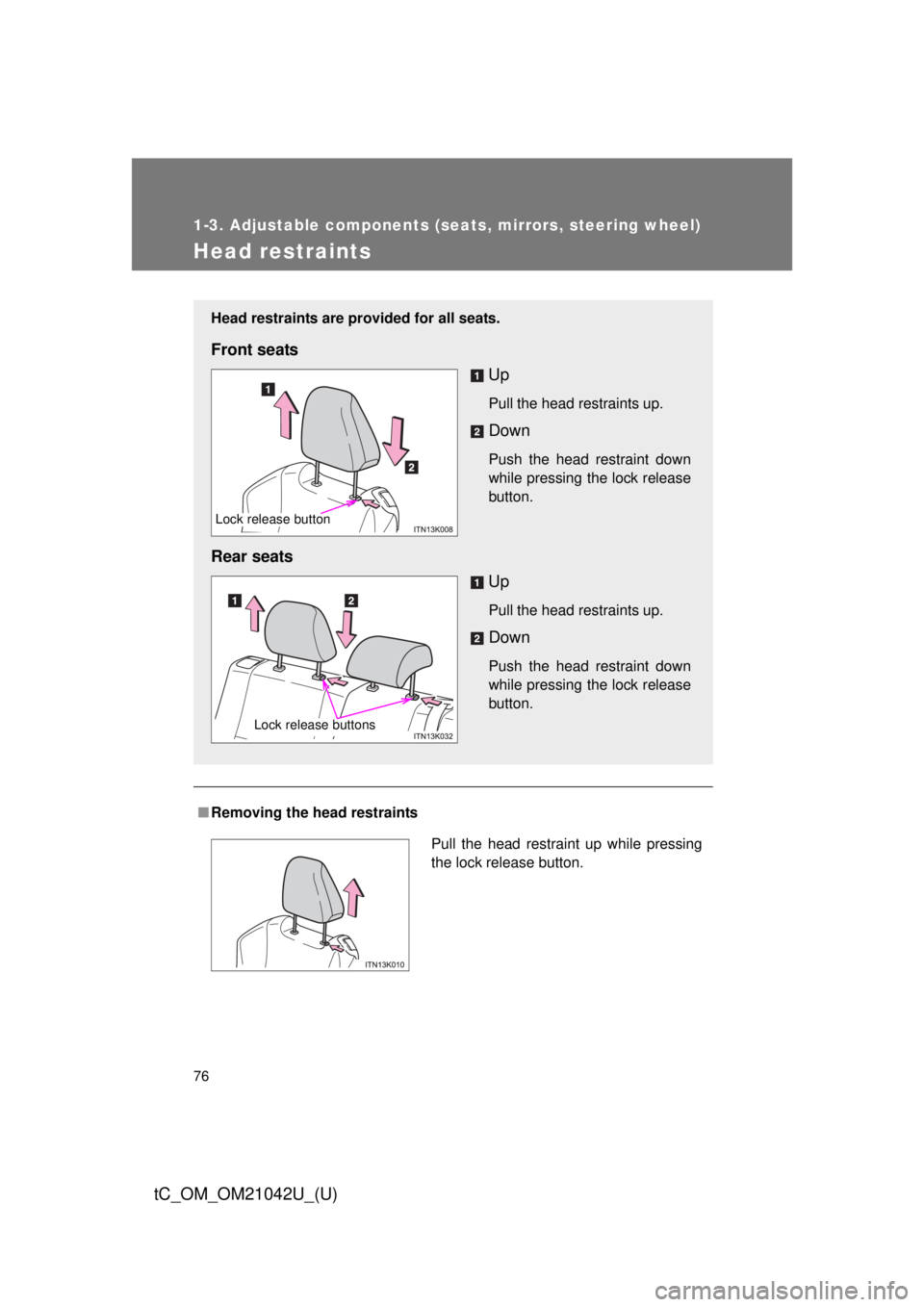
76
1-3. Adjustable components (seats, mirrors, steering wheel)
tC_OM_OM21042U_(U)
Head restraints
■Removing the head restraints
Head restraints are provided for all seats.
Front seats
Up
Pull the head restraints up.
Down
Push the head restraint down
while pressing the lock release
button.
Rear seatsUp
Pull the head restraints up.
Down
Push the head restraint down
while pressing the lock release
button.
Lock release button
Lock release buttons
Pull the head restraint up while pressing
the lock release button.
Page 77 of 484
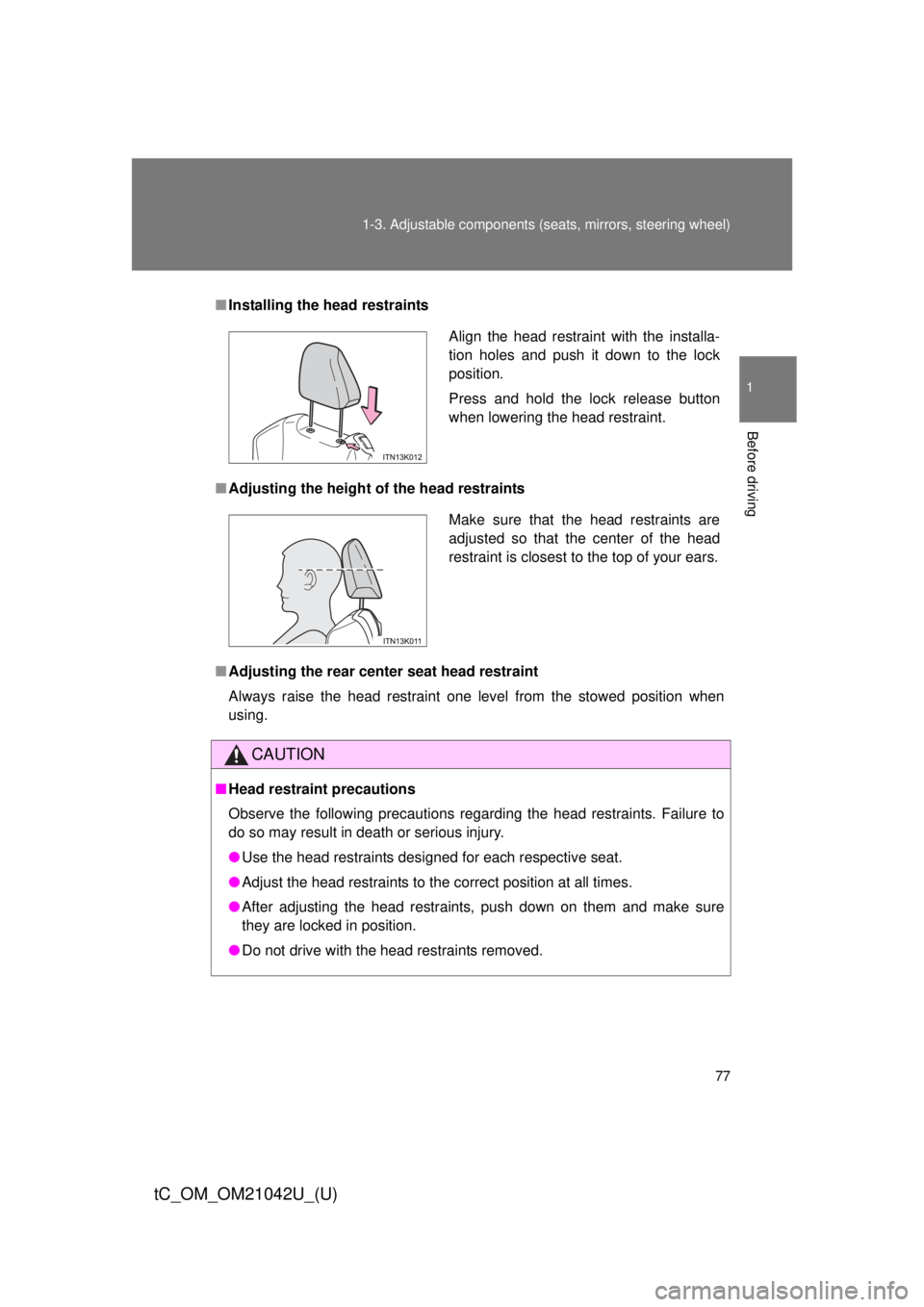
77
1-3. Adjustable components (s
eats, mirrors, steering wheel)
1
Before driving
tC_OM_OM21042U_(U)
■Installing the head restraints
■ Adjusting the height of the head restraints
■ Adjusting the rear cent er seat head restraint
Always raise the head restraint one level from the stowed position when
using.
CAUTION
■ Head restraint precautions
Observe the following precautions regarding the head restraints. Failure to
do so may result in death or serious injury.
● Use the head restraints designed for each respective seat.
● Adjust the head restraints to the correct position at all times.
● After adjusting the head restraints, push down on them and make sure
they are locked in position.
● Do not drive with the head restraints removed.
Align the head restraint with the installa-
tion holes and push it down to the lock
position.
Press and hold the lock release button
when lowering the head restraint.
Make sure that the head restraints are
adjusted so that the center of the head
restraint is closest to the top of your ears.
Page 78 of 484
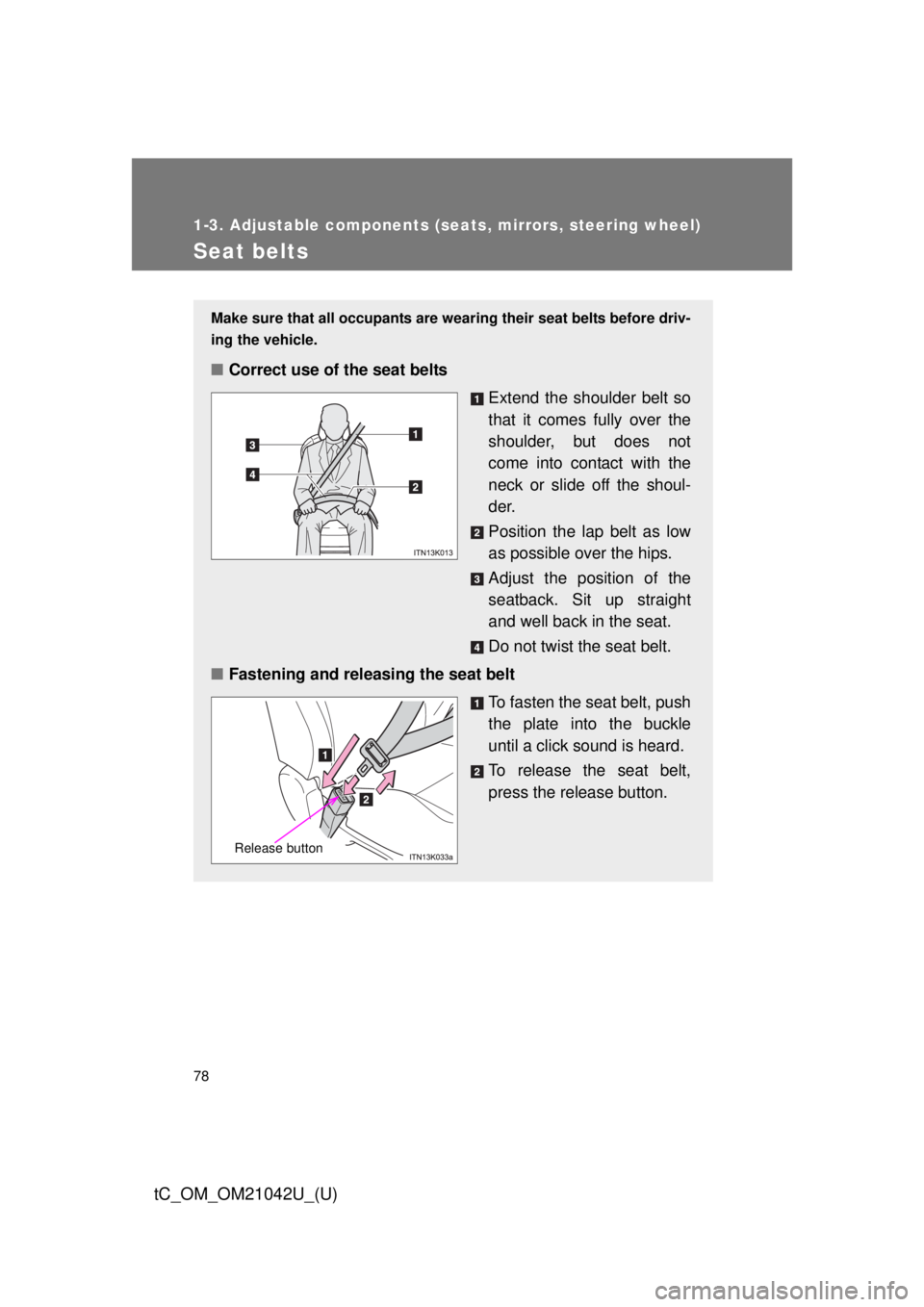
78
1-3. Adjustable components (seats, mirrors, steering wheel)
tC_OM_OM21042U_(U)
Seat belts
Make sure that all occupants are wearing their seat belts before driv-
ing the vehicle.
■Correct use of the seat belts
Extend the shoulder belt so
that it comes fully over the
shoulder, but does not
come into contact with the
neck or slide off the shoul-
der.
Position the lap belt as low
as possible over the hips.
Adjust the position of the
seatback. Sit up straight
and well back in the seat.
Do not twist the seat belt.
■ Fastening and releasing the seat belt
To fasten the seat belt, push
the plate into the buckle
until a click sound is heard.
To release the seat belt,
press the release button.
Release button
Page 79 of 484
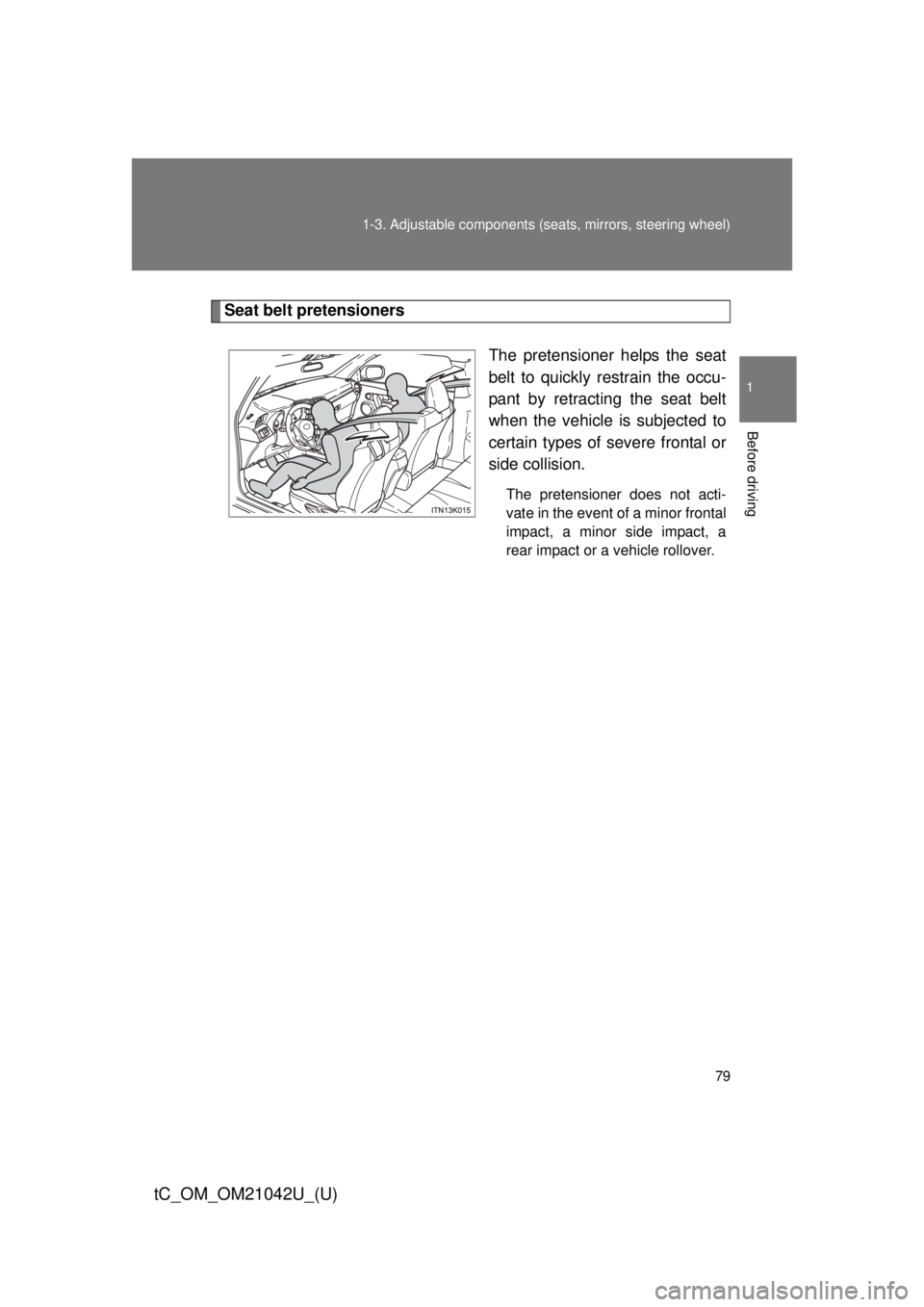
79
1-3. Adjustable components (s
eats, mirrors, steering wheel)
1
Before driving
tC_OM_OM21042U_(U)
Seat belt pretensioners
The pretensioner helps the seat
belt to quickly restrain the occu-
pant by retracting the seat belt
when the vehicle is subjected to
certain types of severe frontal or
side collision.
The pretensioner does not acti-
vate in the event of a minor frontal
impact, a minor side impact, a
rear impact or a vehicle rollover.
Page 80 of 484
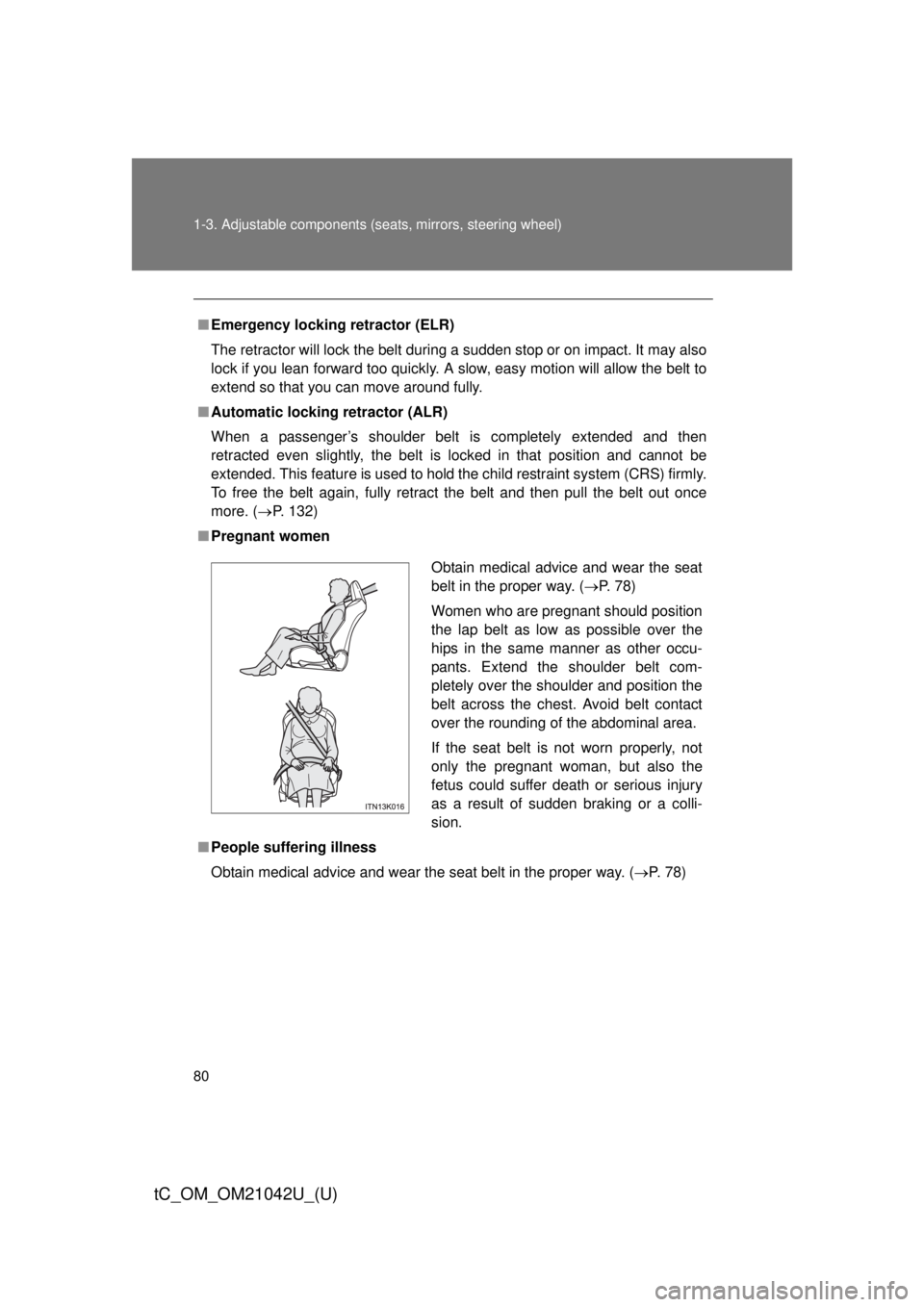
80 1-3. Adjustable components (seats, mirrors, steering wheel)
tC_OM_OM21042U_(U)
■Emergency locking retractor (ELR)
The retractor will lock the belt during a sudden stop or on impact. It may also
lock if you lean forward too quickly. A slow, easy motion will allow the belt to
extend so that you can move around fully.
■ Automatic locking retractor (ALR)
When a passenger’s shoulder belt is completely extended and then
retracted even slightly, the belt is locked in that position and cannot be
extended. This feature is used to hold the child restraint system (CRS) firmly.
To free the belt again, fully retract the belt and then pull the belt out once
more. ( P. 132)
■ Pregnant women
■ People suffering illness
Obtain medical advice and wear the seat belt in the proper way. ( P. 78)
Obtain medical advice and wear the seat
belt in the proper way. (P. 78)
Women who are pregnant should position
the lap belt as low as possible over the
hips in the same manner as other occu-
pants. Extend the shoulder belt com-
pletely over the shoulder and position the
belt across the chest. Avoid belt contact
over the rounding of the abdominal area.
If the seat belt is not worn properly, not
only the pregnant woman, but also the
fetus could suffer death or serious injury
as a result of sudden braking or a colli-
sion.